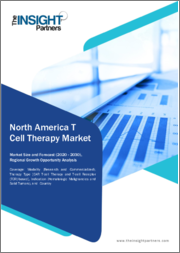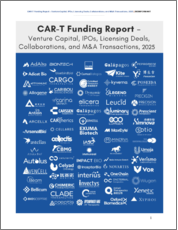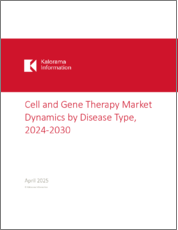
|
시장보고서
상품코드
1452634
북미의 T세포치료 시장 예측(-2030년) : 지역별 분석 - 모달리티별, 치료 유형별, 적응증별North America T Cell Therapy Market Forecast to 2030 - Regional Analysis - by Modality (Research and Commercialized), Therapy Type [CAR T-cell Therapy and T-cell Receptor (TCR)-based], and Indication (Hematologic Malignancies and Solid Tumors) |
||||||
북미의 T세포치료 시장은 2022년에 16억 4,552만 달러로 평가되며, 2030년에는 53억 2,975만 달러에 달할 것으로 예측되며, 2022-2030년의 CAGR은 15.8%로 성장할 것으로 예측되고 있습니다.
T세포치료제 승인 건수 증가로 북미 T세포치료제 시장 성장 견인
표적화된 치료, 더 빠르고 효율적인 회복, 부작용 감소 등은 세포치료의 장점 중 하나입니다. 세포치료는 미국 식품의약국(FDA)이 승인한 제품을 사용할 수 있으므로 전 세계에서 널리 채택되고 있습니다. 아래는 최근 FDA가 승인한 T세포치료제 리스트이다:
예를 들어 2022년 6월 브리스톨 마이어스 스퀴브(Bristol-Myers Squibb)는 CD19 지향성 키메라 항원 수용체(CAR) T세포 치료제인 Breyanzi(lisocabtagene maraleucel)를 대세포 B세포 림프종(LBCL) 성인 환자 치료제로 FDA의 승인을 획득했습니다.의 승인을 획득했습니다.
미 식품의약국(FDA)은 지난 2월 예스카르타(예스카르타, axicabtagene ciloleucel)를 1차 화학면역요법에 불응하거나 1차 화학면역요법 후 12개월 이내에 재발한 대세포 B세포 림프종 성인 환자를 위한 CAR T세포 치료제로 승인했습니다. 예스카르타는 NCCN(National Comprehensive Cancer Network)의 카테고리 1 권고안을 받은 최초의 CAR T세포 치료제입니다.
2022년 2월, FDA는 ciltacabtagene autoleucel(상품명 CARVYKTI)을 프로테아좀 억제제, 면역조절제, 항CD38 모노클로널 항체 등 4가지 이상의 치료 경험이 있는 재발성 또는 불응성 다발성 골수종 성인 환자의 치료제로 승인 승인되었습니다.
2020년 1월, FDA는 HLA-A*02:01 양성인 절제 불가능한 또는 전이성 포도막 흑색종 환자의 치료제로 킴트랙(tebentafusp-tebn)을 승인했습니다.
2021년 3월, 아베쿠마(idecabtagene vicleucel)는 재발성 또는 불응성 다발성 골수종 치료제로 FDA의 승인을 받았습니다. 이 치료제는 B 세포 성숙 항원(BCMA) 지향성 유전자 재조합 자가 T 세포 면역 요법으로 난치성 다발성 골수종 성인 환자 치료에 적응증을 가지고 있습니다.
따라서 T세포치료제 승인 건수 증가는 북미 T세포치료제 시장의 성장을 촉진하고 있습니다.
북미 T세포치료제 시장 개요
북미 T세포치료 시장은 미국, 캐나다, 멕시코로 구분되며, 2022년 미국이 이 지역에서 가장 큰 시장 점유율을 차지할 것으로 예상되며, 암 및 자가면역질환과 같은 만성질환 증가, R&D 활동의 성장, 강력한 시장 기업의 존재로 인해 예측 기간 중 그 우위가 지속될 것으로 예상됩니다. 지속될 것으로 예상됩니다. 또한 CAR T세포치료의 임상 연구가 증가함에 따라 북미 시장은 예측 기간 중 성장할 것으로 예상되며, CDC에 따르면 2020년 미국에서 160만 3,844명의 새로운 암 환자가 보고되고 60만 2,347명이 사망했으며, 2023년에는 미국에서 약 184,720명이 백혈병, 림프종, 암으로 사망할 것으로 예상됩니다. 가 백혈병, 림프종, 골수종 진단을 받을 것으로 예상됩니다.
Tisagenlecleucel(KymriahTM, Novartis, Morris Plains, NJ, 미국)과 axicabtagene ciloleucel(YescartaTM, Gilead Sciences Canada, El Segundo, CA, 미국)는 캐나다 보건부가 2018년과 2019년에 각각 캐나다에서 승인한 최초의 두 가지 CAR T세포로, 캐나다에서 시판되고 있습니다. 이 두 제품은 모두 2세대 항 CD19 CAR T세포로, r/r DLBCL, 원발성 종격동 B세포 림프종, 형질전환 여포성 림프종 성인 환자를 대상으로 승인되었습니다. 또한 Canadian-Led Immunotherapies in Cancer-01(CLIC-01)은 캐나다에서 처음으로 CAR T세포치료를 도입했습니다. 이 치료법은 보다 저렴하고 공평한 치료법을 제시하는 다른 유형의 세포 제조 방법을 사용하고 있습니다. 핼리팩스의 퀸 엘리자베스 2세 건강 과학 센터는 2022년 3월부터 캐나다 대서양 연안에서 CAR T세포치료를 제공하는 최초의 시설이 되었습니다. 이전에는 이 고도로 맞춤화된 암 치료제를 추천받은 노바스코샤주 환자들은 치료를 받기 위해 해외로 나가야만 했습니다. 이 프로그램은 미국 정부의 연간 670만 달러의 투자로 실현되었습니다. 이처럼 암 환자 증가와 정부의 구상은 북미 T세포 치료제 시장을 촉진하고 있습니다.
북미 T세포치료제 시장 매출 및 2030년까지의 예측(US$Mn)
북미 T세포치료제 시장 세분화
북미 T세포치료제 시장은 치료법, 치료 유형, 적응증, 국가별로 구분됩니다.
양식에 따라 북미 T세포치료 시장은 연구와 상업화로 나뉘며, 2022년 시장 점유율은 상업화 부문에서 더 큰 비중을 차지할 것으로 예상됩니다.
치료 유형에 따라 북미 T세포치료 시장은 CAR T세포치료와 T 세포 수용체(TCR) 기반으로 나뉘며, 2022년 시장 점유율은 CAR T세포치료가 더 높을 것으로 예상됩니다.
적응증에 따라 북미 T세포치료 시장은 혈액 악성 종양과 고형 종양으로 나뉘며, 2022년에는 혈액 악성 종양 분야가 가장 큰 시장 점유율을 차지했습니다.
국가별로 북미 T세포치료 시장은 미국, 캐나다, 멕시코로 구분되며, 2022년 북미 T세포치료 시장 점유율은 미국이 독차지했습니다.
Bluebird Bio Inc, Bristol-Myers Squibb Co, Cartesian Therapeutics Inc, Gilead Sciences Inc, Innovent Biologics Inc, Janssen Global Services LLC, Novartis AG는 북미 T세포치료제 시장에서 사업을 운영하고 있는 주요 기업입니다.
목차
제1장 서론
제2장 주요 요약
- 주요 인사이트
- 북미의 T세포치료 시장, 국가별
제3장 조사 방법
- 조사 범위
- 2차 조사
- 1차 조사
제4장 북미의 T세포치료 시장 : 주요 산업 역학
- 시장 촉진요인
- 세계 암이환율의 증가
- T세포치료 승인수의 증가
- 시장 억제요인
- CAR T세포치료의 부작용
- 시장 기회
- T세포치료에 대한 투자의 증가
- 향후 동향
- 임상시험중인 CAR T세포치료 수의 증가
- 영향 분석
제5장 T세포치료 시장 : 북미 시장 분석
- 북미의 T세포치료 시장 매출, 2022-2030년
제6장 북미의 T세포치료 시장 : 매출과 2030년까지의 예측 - 모달리티별
- 시장 매출 점유율(%), 2022년 및 2030년
- 연구
- 상업화
제7장 북미의 T세포치료 시장 : 매출과 2030년까지의 예측 - 치료 유형별
- 시장 매출 점유율(%), 2022년 및 2030년
- CAR T세포치료
- T세포 수용체(TCR) 기반
제8장 북미의 T세포치료 시장 : 매출과 2030년까지의 예측 - 적응증별
- 시장 매출 점유율(%), 2022년 및 2030년
- 혈액 악성 종양
- 고형암
제9장 북미의 T세포치료 시장 : 국가별 분석
- 북미의 T세포치료 시장 : 국가별
- 미국
- 캐나다
- 멕시코
제10장 T세포치료 시장 : 업계 상황
- T세포치료 시장의 성장 전략
- 유기적 성장 전략
- 무기적 성장 전략
제11장 기업 개요
- Legend Biotech Corp
- Janssen Global Services LLC
- Gilead Sciences Inc
- Bristol-Myers Squibb Co
- Novartis AG
- Cartesian Therapeutics Inc
- Innovent Biologics Inc
제12장 부록
KSA 24.04.29The North America T cell therapy market was valued at US$ 1,645.52 million in 2022 and is expected to reach US$ 5,329.75 million by 2030; it is estimated to grow at a CAGR of 15.8% from 2022 to 2030.
Increasing Number of T-Cell Therapy Approvals Fuels the North America T Cell Therapy Market
Targeted treatment, faster and more efficient recovery, and reduced side effects are among the advantages of cell therapy. Globally, cell therapies are widely adopted owing to the availability FDA approved products. Following is the list of T-cell therapy products approved by FDA in recent years:
For instance, in June 2022, Bristol Myers Squibb received FDA approval for Breyanzi (lisocabtagene maraleucel), a CD19-directed chimeric antigen receptor (CAR) T-cell therapy, for the treatment of adult patients with large B-cell lymphoma (LBCL).
In February 2022, the US Food and Drug Administration (FDA) approved Yescarta (axicabtagene ciloleucel) CAR T-cell therapy for adult patients with large B-cell lymphoma that is refractory to first line chemoimmunotherapy or that relapses within 12 months of first line chemoimmunotherapy. Yescarta is the first CAR T-cell therapy to receive a National Comprehensive Cancer Network (NCCN) Category 1 recommendation.
In February 2022, the FDA approved ciltacabtagene autoleucel (brand name CARVYKTI) for treating adult patients with relapsed or refractory multiple myeloma after four or more prior lines of therapy, including a proteasome inhibitor, an immunomodulatory agent, and an anti-CD38 monoclonal antibody.
In January 2022, the FDA approved Kimmtrak (tebentafusp-tebn) for treating unresectable or metastatic uveal melanoma patients who are HLA-A*02:01 positive.
In March 2021, Abecma (idecabtagene vicleucel) was approved by the FDA for treating relapsed or refractory multiple myeloma. The treatment is a B-cell maturation antigen (BCMA)-directed genetically modified autologous T-cell immunotherapy indicated for treating adult patients with refractory multiple myeloma.
Therefore, the increasing number of approvals for T-cell therapies is fueling the North America T cell therapy market growth.
North America T Cell Therapy Market Overview
The T-cell therapy market in North America is segmented into the US, Canada, and Mexico. In 2022, the US held the largest market share in this region and is expected to continue its dominance during the forecast period due to the increasing burden of chronic disorders such as cancer and autoimmune disorders, growth in research and development activities, and strong and established market players. Also, with an increase in clinical studies in CAR T-cell therapies, the market in North America is expected to grow during the forecast period. According to CDC, 1,603,844 new cancer cases were reported and 602,347 people died in the US in 2020. An estimated 184,720 people in the US will be diagnosed with leukemia, lymphoma, or myeloma in 2023.
Tisagenlecleucel (KymriahTM, Novartis, Morris Plains, NJ, US) and axicabtagene ciloleucel (YescartaTM, Gilead Sciences Canada, El Segundo, CA, US) were the first two CAR T-cells commercially available and approved in Canada by Health Canada in 2018 and 2019, respectively. Both are second-generation anti-CD19 CAR T-cells, approved for adult patients with r/r DLBCL, primary mediastinal B-cell lymphoma, and transformed follicular lymphoma. Moreover, Canadian-Led Immunotherapies in Cancer-01 (CLIC-01) is the first to introduce CAR T-cell therapy in Canada. It uses a different kind of cell manufacturing that unveils less expensive and more equitable treatment. The Queen Elizabeth II Health Sciences Centre in Halifax became the first facility in Atlantic Canada to offer CAR T-cell therapy locally as of March 2022. Prior to this, Nova Scotia patients who were recommended for this highly personalized cancer medicine had to travel outside the country to receive the treatment. The program was made possible with a government investment of US$ 6.7 million annually. Thus, the rising cancer cases and initiative by the government fuel the T-cell therapy market in North America.
North America T Cell Therapy Market Revenue and Forecast to 2030 (US$ Mn)
North America T Cell Therapy Market Segmentation
The North America T cell therapy market is segmented into modality , therapy type, indication, and country.
Based on modality, the North America T cell therapy market is bifurcated into research and commercialized. The commercialized segment held a larger market share in 2022.
Based on therapy type, the North America T cell therapy market is divided into CAR T-cell therapy and T-cell Receptor (TCR)-based. The CAR T-cell therapy segment held a larger market share in 2022.
Based on indication, the North America T cell therapy market is bifurcated into hematologic malignancies and solid tumors. The hematologic malignancies segment held the largest market share in 2022.
Based on country, the North America T cell therapy market is segmented into the US, Canada, and Mexico. The US dominated the North America T cell therapy market share in 2022.
Bluebird Bio Inc, Bristol-Myers Squibb Co, Cartesian Therapeutics Inc, Gilead Sciences Inc, Innovent Biologics Inc, Janssen Global Services LLC, and Novartis AG are some of the leading companies operating in the North America T cell therapy market.
Table Of Contents
1. Introduction
- 1.1 The Insight Partners Research Report Guidance
- 1.2 Market Segmentation
2. Executive Summary
- 2.1 Key Insights
- 2.2 North America T Cell Therapy Market, by Country (US$ Million)
3. Research Methodology
- 3.1 Coverage
- 3.2 Secondary Research
- 3.3 Primary Research
4. North America T Cell Therapy Market - Key Industry Dynamics
- 4.1 Market Drivers:
- 4.1.1 Growing Burden of Cancer Worldwide
- 4.1.2 Increasing Number of T-Cell Therapy Approvals
- 4.2 Market Restraints
- 4.2.1 Side-effects of CAR T-Cell Therapy
- 4.3 Market Opportunities
- 4.3.1 Growing Investment in T-Cell Therapy
- 4.4 Future Trends
- 4.4.1 Rising Number of CAR T-Cell Therapies in Clinical Trials
- 4.5 Impact Analysis:
5. T Cell Therapy Market - North America Market Analysis
- 5.1 North America T Cell Therapy Market Revenue (US$ Mn), 2022 - 2030
6. North America T Cell Therapy Market - Revenue and Forecast to 2030 - by Modality.
- 6.1 Overview
- 6.2 North America T Cell Therapy Market Revenue Share, by Modality, 2022 & 2030 (%)
- 6.3 Research
- 6.3.1 Overview
- 6.3.2 Research: North America T Cell Therapy Market - Revenue and Forecast to 2030 (US$ Million)
- 6.4 Commercialized
- 6.4.1 Overview
- 6.4.2 Commercialized: North America T Cell Therapy Market - Revenue and Forecast to 2030 (US$ Million)
7. North America T Cell Therapy Market - Revenue and Forecast to 2030 - by Therapy Type
- 7.1 Overview
- 7.2 North America T Cell Therapy Market Revenue Share, by Therapy Type 2022 & 2030 (%)
- 7.3 CAR T-cell Therapy
- 7.3.1 Overview
- 7.3.2 CAR T-cell Therapy: North America T Cell Therapy Market - Revenue and Forecast to 2030 (US$ Million)
- 7.4 T-cell Receptor (TCR)-based.
- 7.4.1 Overview
- 7.4.2 T-cell Receptor (TCR)-based: North America T Cell Therapy Market - Revenue and Forecast to 2030 (US$ Million)
8. North America T Cell Therapy Market - Revenue and Forecast to 2030 - by Indication.
- 8.1 Overview
- 8.2 North America T Cell Therapy Market Revenue Share, by Indication, 2022 & 2030 (%)
- 8.3 Hematologic Malignancies
- 8.3.1 Overview
- 8.3.2 Hematologic Malignancies: North America T Cell Therapy Market - Revenue and Forecast to 2030 (US$ Million)
- 8.3.3 North America T Cell Therapy Market, by Haematological Malignancies, 2020-2030 (US$ Million)
- 8.4 Solid Tumor
- 8.4.1 Overview
- 8.4.2 Solid Tumor: North America T Cell Therapy Market - Revenue and Forecast to 2030 (US$ Million)
9. North America T Cell Therapy Market - Country Analysis
- 9.1 Overview
- 9.1.1.1 North America T Cell Therapy Market, by Country
- 9.1.1.2 US
- 9.1.1.2.1 US: North America T Cell Therapy Market Revenue and Forecast to 2030 (US$ Mn)
- 9.1.1.2.2 US: North America T Cell Therapy Market, by Modality, 2020-2030 (US$ Million)
- 9.1.1.2.3 US: North America T Cell Therapy Market, by Therapy Type, 2020-2030 (US$ Million)
- 9.1.1.2.4 US: North America T Cell Therapy Market, by Indication, 2020-2030 (US$ Million)
- 9.1.1.2.4.1 US: North America T Cell Therapy Market, For Hematologic Malignancies by Indication, 2020-2030 (US$ Million)
- 9.1.1.3 Canada
- 9.1.1.3.1 Canada: North America T Cell Therapy Market Revenue and Forecast to 2030 (US$ Mn)
- 9.1.1.3.2 Canada: North America T Cell Therapy Market, by Modality, 2020-2030 (US$ Million)
- 9.1.1.3.3 Canada: North America T Cell Therapy Market, by Therapy Type, 2020-2030 (US$ Million)
- 9.1.1.3.4 Canada: North America T Cell Therapy Market, by Indication, 2020-2030 (US$ Million)
- 9.1.1.3.4.1 Canada: North America T Cell Therapy Market, For Hematologic Malignancies by Indication, 2020-2030 (US$ Million)
- 9.1.1.4 Mexico
- 9.1.1.4.1 Mexico: North America T Cell Therapy Market Revenue and Forecast to 2030 (US$ Mn)
- 9.1.1.4.2 Mexico: North America T Cell Therapy Market, by Modality, 2020-2030 (US$ Million)
- 9.1.1.4.3 Mexico: North America T Cell Therapy Market, by Therapy Type, 2020-2030 (US$ Million)
- 9.1.1.4.4 Mexico: North America T Cell Therapy Market, by Indication, 2020-2030 (US$ Million)
- 9.1.1.4.4.1 Mexico: North America T Cell Therapy Market, For Hematologic Malignancies by Indication, 2020-2030 (US$ Million)
10. T Cell Therapy Market-Industry Landscape
- 10.1 Overview
- 10.2 Growth Strategies in T Cell Therapy Market
- 10.3 Organic Growth Strategies
- 10.3.1 Overview
- 10.4 Inorganic Growth Strategies
- 10.4.1 Overview
11. Company Profiles
- 11.1 Legend Biotech Corp
- 11.1.1 Key Facts
- 11.1.2 Business Description
- 11.1.3 Products and Services
- 11.1.4 Financial Overview
- 11.1.5 SWOT Analysis
- 11.1.6 Key Developments
- 11.2 Janssen Global Services LLC
- 11.2.1 Key Facts
- 11.2.2 Business Description
- 11.2.3 Products and Services
- 11.2.4 Financial Overview
- 11.2.5 SWOT Analysis
- 11.2.6 Key Developments
- 11.3 Gilead Sciences Inc
- 11.3.1 Key Facts
- 11.3.2 Business Description
- 11.3.3 Products and Services
- 11.3.4 Financial Overview
- 11.3.5 SWOT Analysis
- 11.3.6 Key Developments
- 11.4 Bristol-Myers Squibb Co
- 11.4.1 Key Facts
- 11.4.2 Business Description
- 11.4.3 Products and Services
- 11.4.4 Financial Overview
- 11.4.5 SWOT Analysis
- 11.4.6 Key Developments
- 11.5 Novartis AG
- 11.5.1 Key Facts
- 11.5.2 Business Description
- 11.5.3 Products and Services
- 11.5.4 Financial Overview
- 11.5.5 SWOT Analysis
- 11.5.6 Key Developments
- 11.6 Cartesian Therapeutics Inc
- 11.6.1 Key Facts
- 11.6.2 Business Description
- 11.6.3 Products and Services
- 11.6.4 Financial Overview
- 11.6.5 SWOT Analysis
- 11.6.6 Key Developments
- 11.7 Innovent Biologics Inc
- 11.7.1 Key Facts
- 11.7.2 Business Description
- 11.7.3 Products and Services
- 11.7.4 Financial Overview
- 11.7.5 SWOT Analysis
- 11.7.6 Key Developments
12. Appendix
- 12.1 About Us
- 12.2 Glossary of Terms



















